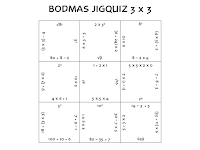This site has some amazing support for developing number sense as well as other ares in mathematics
These games have come form this site...
Games can be very useful for reinforcing and developing ideas and procedures previously introduced to children. Although a suggested age group is given for each of the following games, it is the children's level of experience that should determine the suitability of the game. Several demonstration games should be played, until the children become comfortable with the rules and procedures of the games.
Deal and Copy (4-5 years) 3-4 players
Materials: 15 dot cards with a variety of dot patterns representing the numbers from one to five and a plentiful supply of counters or buttons.
Rules: One child deals out one card face up to each other player. Each child then uses the counters to replicate the arrangement of dots on his/her card and says the number aloud. The dealer checks each result, then deals out a new card to each player, placing it on top of the previous card. The children then rearrange their counters to match the new card. This continues until all the cards have been used.
Variations/Extensions
Deal and Copy (4-5 years) 3-4 players
Materials: 15 dot cards with a variety of dot patterns representing the numbers from one to five and a plentiful supply of counters or buttons.
Rules: One child deals out one card face up to each other player. Each child then uses the counters to replicate the arrangement of dots on his/her card and says the number aloud. The dealer checks each result, then deals out a new card to each player, placing it on top of the previous card. The children then rearrange their counters to match the new card. This continues until all the cards have been used.
Variations/Extensions
- Each child can predict aloud whether the new card has more, less or the same number of dots as the previous card. The prediction is checked by the dealer, by observing whether counters need to be taken away or added.
- Increase the number of dots on the cards.
Memory Match (5-7 years) 2 players
Materials: 12 dot cards, consisting of six pairs of cards showing two different arrangements of a particular number of dots, from 1 to 6 dots. (For example, a pair for 5 might be Card A and Card B from the set above).
Rules: Spread all the cards out face down. The first player turns over any two cards. If they are a pair (i.e. have the same number of dots), the player removes the cards and scores a point. If they are not a pair, both cards are turned back down in their places. The second player then turns over two cards and so on. When all the cards have been matched, the player with more pairs wins.
Variations/Extensions
- Increase the number of pairs of cards used.
- Use a greater number of dots on the cards.
- Pair a dot card with a numeral card.
What's the Difference? (7-8 years) 2-4 players
Materials: A pack of 20 to 30 dot cards (1 to 10 dots in dice and regular patterns), counters.
Rules: Spread out 10 cards face down and place the rest of the cards in a pile face down. The first player turns over the top pile card and places beside the pile. He/she then turns over one of the spread cards. The player works out the difference between the number of dots on each card, and takes that number of counters. (E.g. If one card showed 3 dots and the other 8, the player would take 5 counters.) The spread card is turned face down again in its place and the next player turns the top pile card and so on. Play continues until all the pile cards have been used. The winner is the player with the most counters; therefore the strategy is to remember the value of the spread cards so the one that gives the maximum difference can be chosen.
Variations/Extensions
- Try to turn the spread cards that give the minimum difference, so the winner is the player with the fewest counters.
- Roll a die instead of using pile cards. Start with a set number of counters (say 20), so that when all the counters have been claimed the game ends.
- Use dot cards with random arrangements of dots.
















